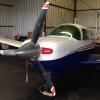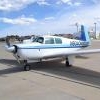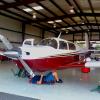Leaderboard
Popular Content
Showing content with the highest reputation on 01/15/2017 in all areas
-
Check the mag timing. This could had changed when the cables were replaced. José3 points
-
I'm late to the thread but 3/4" galvanized pipe makes a great sacrificial towbar. You will break the elbow before you damage the truss if turned too sharply. I'll occasionally tow my J 1/4 mile to the SS gas pump and back with my handy-dandy homemade electric tug. And in a pinch it's great for negotiating the aisles of Walmart.[emoji5] Sent from my iPad using Tapatalk3 points
-
Clarence: With only 50 gals on board, we will run the tanks dry before we can get airborne.3 points
-
3 points
-
I went to the airport last night to drop off some stuff and wanted to preflight the plane, grab the nav data card to update, etc prior to a planned flight today. Anyway I found this ... I didn't leak test with the boost fuel pump pressurizing, but thought I had enough evidence to remove the offending line. It appeared like there was a minuscule crack at the solder joint at which fuel was leaking. Removed the offending fuel line and examined more closely. Yup it's cracked. If these things didn't cost $100 for 18 inches of 1/8 diameter tube with two poorly soldered nipple ends I'd replace all four. Called my AP today, who was nice enough to talk to me on a Sunday of a holiday weekend - he doesn't have any so we'll install a new one next week. So much for flying today. :-( Sent from my iPhone using Tapatalk2 points
-
Once again a great example of an owner, admittedly not a tech guy, opens his cowling and finds something that could have been disastrous. I am going to work on a video soon that I’ll post in my blog area that shows what an owner/operator, who is not an A&P, can do as an extended preflight. It will be a de-cowling and we will point out what to look for. Someone did this for me, so I want to pass it on.2 points
-
Do you expect royalties for your idea?[emoji846] Most of the tenants at my new home-base looked at me funny as I dragged the plane around, but once I hopped out of the seat many came around to check out my custom electric tug. The best part is I also use it to open and close my big-ass heavy sticky rolling hangar doors. My back hasn't hurt in months! Sent from my iPad using Tapatalk2 points
-
Absoluteky. But one I got the hang of it, wow. I'm not talking about following magenta lines, but the situational awareness created by the act of loading an approach and, especially, selecting a transition. Consider: you are a half hour out from your destination nontowered airport. You are going to be telling ATC what you want. First, you need the know the weather, especially the wind direction to even select which approach to which runway; the days of a single off airport VOR or sole ILS or LOC option are gone. Once you choose the approach, choosing a transition requires you to know exactly where you are coming from and how your approach fits into the enroute environment. Done right, it's quite the opposite of "magenta line" mentality. The options provided by GPS approaches require us to know where we are, where we are going, and how to best get there. To know what the weather is doing. That, in turn, forces us to stay way ahead of the airplane. And to manage our time. Those are, of course, important for any approach or phase of flight, but I think they are forced in us by these extra options.2 points
-
https://www.hobbyzone.com/hangar9/all/han156.html?gclid=CObIxbOuw9ECFZyEswod3tIBBQ under $30 and highly accurate.2 points
-
Sorry, I'm using N252AD right now I don't use the O2 on every flight and actually probably on only 20% of my flights. But I sure like the ability to go to 24K or even 28K if I need to, if even for a short time.2 points
-
juke, I believe what you MEANT to say to mooney_mike was: THIS POST IS USELESS WITHOUT PICS!!!!!!!!! but I got yer back!2 points
-
Manual gear or electric gear makes a big difference in procedure here. With manual gear, as you get better with the johnson bar procedure, you'll want to pull the gear almost as soon as you break ground. The Mooney accelerates so quickly, and the faster you go, the heavier the gear get, and more difficult to retract. So get them up quickly. I'll have to disagree with my friend from the old country. I always pull the gear as soon as I have positive rate of climb. I'd much rather have altitude instead of remaining runway. More and more CFI's I talk with agree that the whole "useable runway" is going out of favor. With the gear up, climb is better. If the engine quits, I'd rather have the altitude. Also, the gear travel on the Mooney's is so quick, that if the engine quits and I've still got runway, I'll just put the wheels down again. Regardless, you'll climb better with the gear stowed. So for a short field, I'll pull the gear ASAP.2 points
-
2 points
-
I had a Bonanza painted at Lancaster Aero , Smoketown PA , Shot in Imron , Multi Color scheme , full strip , also magnesium surfaces , South of 15 K , 5 weeks start to finish.....2 points
-
I thought I would start this thread to capture resources needed for the ADS-B mandate: Interactive site that shows the ADS-B coverage by type: https://www.faa.gov/nextgen/programs/adsb/ICM/ Link to an interactive Google Earth site that allows you to search for airports to show whether ADS-B out is required (also helped validate why active traffic is not such a bad thing - check out the video): https://www.faa.gov/nextgen/equipadsb/airspace/ The flight test requirements (section 4.3): https://www.faa.gov/documentLibrary/media/Advisory_Circular/AC_20-165B.pdf The FAA's rebate program website: https://www.faa.gov/nextgen/equipadsb/rebate/ Hope this helps.1 point
-
1 point
-
Hopefully this is my final update on this miserable topic. After after replacing the rpm sensor, it worked fine for several months. Then it started reading erratically again, particularly at high rpm for takeoff. I went back to the avionics shop - the pins in the connector for the sensor were re-crimped. It worked fine for another month and then the problem returned. When I went to fly it home from annual, the issue was unbearably bad, and I returned to land. The avionics tech at the shop simply applied some of this Stabilant 22 stuff to the connector: http://ralaudio.com/stabilant-22-contact-enhancer-m-2.html This appears to have completely resolved the problem! I wish we had tried this in the first place. I suspect the original sensor was never really defective, and this has been a pointless wild goose chase.1 point
-
Once again a great example of an owner, admittedly not a tech guy, opens his cowling and finds something that could have been disastrous.1 point
-
You have to be gallant and chivalrous to the pretty lady on the phone! And not make fun of uhm...fat and uhm...well...ugly... women! They do stick together and word travels faster than a speeding Mooney! Just ask Chris why he never got anything! Not even a pen!1 point
-
Richard, The oddity of the situation is something changed unexpectedly... 1) a timing change is usually a less visible but more serious power change. It shows in performance, EGT, and CHTs... not usually an rpm change... the seriousness is because it may be a loose mag that (at worst) can fall off and bleed a lot of oil... 2) if a plug were not working because of a broken new wire, it would show up during the run-up. 3) downloading data from a JPI would indicate intermittent problems. 4) what is the chance that an ignition wire is mis wired or grounding out...? The list of things to check is probably a good thing to take to your mechanic to review the normal things that have been done to the unusual thing that may be happening... PP thoughts only, not a mechanic... Best regards, -a-1 point
-
I agree. This is my third Bruce's for this plane but since I've only owned Bruce's I wasn't sure the alternatives.1 point
-
You mean I have always paid them too promptly. Talk about good customer relations.1 point
-
I don't disagree with you at all. Maybe complexity isn't the best word to describe it. I think there is lot to learn coming from VOR & ILS only as we both did - but none of it what I would really describe as adding operational complexity than what we already had with ILS & VOR - in fact I feel GPS simplifies things greatly from before GPS. What I find is clients/students being overwhelmed about using the GPS properly. But as CFII we know the avionics really well, or should, and can show how to simply usage of the box and break down when to do what so as to stay ahead of the plane. For example, having the expected approach loaded but not activated before we leave the enroute portion, then activating the approach as soon as we are on our first vector for the approach. The GPS is especially valuable when we get to partial panel training. I still require my students to know how to use the compass per ACS standards, but partial panel approaches are done using TRK and DTK GPS data (not following the magenta line) which allows them to fly partial panel to ATP standards. Very little understanding of TERPS complexities are needed to be safe. But I really stress survival tactics, and an example one important one is VDP. But what I stress is its the absence of a VDP which is so important since it means we have obstacles to avoid in the visual segment. There are additional survival aspects of the VDP which include recognizing when flying an LNAV approach to minimums that there is no TERPS requirement that the charted required approach visibility is enough to see the threshold from the VDP at minimums - so what will be our plan? To sum it up, rather than harp on complexity, I try to stress how to use the box to simplify our workload, rather than be consumed by it, and then do my best to make sure they understand the important gotcha's and survival tactics that at least I've learned over the past 27 years of flying and still learning.1 point
-
Electronic AI's get their orientation from what is essentially a solid state electrical gyro. It's a chip on a circuit board. The pitot/static and GPS are supplementary to the device's operation. The Aspen requires the pitot/static, or it goes red X's. The G5 still functions without the pitot/static or GPS. They're just supplemental to the calculation that results in what you see on the display. I don't think the pitot/static and GPS are the primary way any electric AI calculates it's orientation in space.1 point
-
This somewhat does make sense to me. Let me try to explain... or at least how I understand it. There are certain instruments that are certified as Primary without any back up (G5, SAI-340, D10A, your vacuum driven mechanical AI, etc.) Other instruments are certified to be Primary, but require a Backup (not Standby) these include the Aspen and G500. The AI's that require a Backup, require that the Backup have a different source of orientation information (not a different source of power). The Aspen/G500 get their orientation by a combination of Pitot/Static and GPS. Therefore the backup must get it's orientation through some other method. Your vacuum driven AI gets its orientation from the gyro's and is powered by vacuum. The G5/SAI-340/D10A/etc get their orientation from pitot/static and gps which is the same as the Aspen/G500 and therefore can't be their backup. Supposedly the G5/SAI-340/D10A all claim that even if the pitot/static fails, they are still as accurate as your mechanical gauge. But evidently only the ESI-500 is certified without the pitot/static and therefore will satisfy the requirements of Aspen and Garmin to back up their glass. We believe the G5/SAI-340/D10A will all do just as well, but haven't been certified to that standard. Evidently there are some installers who are confident enough in their capability and the accompanying documentation to do the installs and signs the logs. This is my understanding as a PP, not AI/A&P/FSDO/Garmin/Aspen/Dynon engineer.1 point
-
I was always very happy with my Bruce's cover, engine plugs and pitot cover. High quality to say the least.1 point
-
+1... I left mine on the ramp in the Socal heat and sun. The cabin was not too bad and I didn't melt my hand off when grabbing the center beam when getting in like I had in the past. The beam was just warm to the touch, so the cover is definitely protecting the inside of the plane...1 point
-
I have a Bruces cover and the snaps are definitely optional. I've decided not to install the snaps, and will just use the nice wide straps that came with the cover. Of course, the plane lives in a hangar so the cover is only used for overnight trips where it might be out on the ramp.1 point
-
Good question. I don't really have a problem to be at the right speed with this RPM setting. But in my mind in the case of sudden missed approach I am ready to climb. But it's me. Unless it's totally wrong and dangerous.1 point
-
Rain X will eat through your paint. It won't just discolor it. But some type of hydrophobic coating would be the best solution.1 point
-
I've searched this thread up and down. I do not find one knee of a bee.1 point
-
Yep, anytime you see a Mooney take off, anywhere... if it's a J-bar Mooney, you'll see the gear disappear almost immediately on breaking ground. But don't try it your first time. It will take a few cycles to get comfortable with that Johnson bar. The first time you swing it, it will be a bit like wrestling a snake in the cockpit. But after 10 times or so, it will almost swing its self and will be very easy. But if you wait until you're past 90 mph, it will probably be a two handed job. So earlier is better.1 point
-
whichever one of these devices (G5, D10A, etc) adds the ability to drive a King autopilot first, will get my money..... or if Aspen brings down the price of their EA100 to something a little more reasonable than 3AMU's (like maybe 1AMU.. which is still overpriced).1 point
-
There is no replacement for displacement. That being said, you went on a single round trip flight, in one J model, with another pilot flying who may or may not know how to get the best out of his airplane. My observations would be the following: 1) If I owned a J model that trued at just 150kts at 7000ft, I would be investigating what the problem was. 150kts is the bottom of the barrel for a J model unless he was LOP in which case he should not have been burning 10GPH at 7000ft. That's where I flight plan my box stock geriatric F model and I often see more. 2) Getting the most out of an airplane requires planning. In a true XC situation, one would climb high to sip fuel with the best tail wind and return lower out of the strong winds. You seem to be implying that 11,000ft is "Ovation Country". A J model is extremely usable in the 10,000ft to 15,000ft range. Climb rate starts to drop off above 12,500ft but a good J should average more than 500FPM in a climb to 12,000ft. 3) The actual TAS difference between a well performing J and R at max cruise is about 25kts making the R about 15% faster in a race. The difference in fuel burn is about 5gph. This means that the R is burning about 50% more gas at max cruise. If you think that cross country block times will be 15% faster, I would bet that is highly optimistic even on longer trips, on short trips you get bragging right for landing a few minutes earlier and burning a lot more gas. Unfortunately, I would bet that block fuel burn will be 50% more for the R all other things being equal. 4) Useful load. I don't know the exact numbers for either specific plane, but both of the Rs I am familiar with weigh in at near 2400lbs with a useful of about 965lbs. I contrast that with my lowly 200hp F's dry weight of 1681lbs with a useful of 1059lbs. Let's compare a 500nm trip for a typical couple in both planes with 45min reserves. Using numbers for my F model pilot and spouse - 305lbs bags - 100lbs Fuel - 240lbs Aircraft dry weight 1681lbs Total payload and fuel 645lbs Total weight 2326lbs (note that loaded for the trip my plane is lighter than an empty R model). Power to weight ratio is .086hp for every lb. For a typical R Model pilot and spouse - 305lbs bags - 100lbs Fuel - 317lbs Aircraft dry weight 2395lbs. Total payload and fuel 722lbs Total weight 3117lbs Power to weight of .09hp per lb. Not really a huge power to weight ratio benefit for a normal XC mission. If the plane is being flown solo, then the P/W spread is greater, but you should understand that the 180 and 200hp machines do quite well when flown solo as well. Plenty of folks seeing initial climb rates of well over 1200fpm when flying solo in the cooler months of the year; great climb rates are not solely the purview of the big Conti's. I can often hold greater than 1000fpm all the way to 8000 in the cool months. 5) I'm not so sure that any long body has superior short field performance either in or out when compared to a 200hp mid or short bodied bird. Check your POH and compare. I believe that at gross weight as well as lightly loaded, the R is going to use more runway when compared to the lighter short and mid-bodies. My POH says a 200hp F will have a take off roll at MGW on a standard day of 880ft. Configured for the above mentioned 500nm XC trip the POH says 595ft at SL on a standard day. I am not trying to poo poo the big Conti-engined birds. I think they are great machines, especially if you fly alone a lot and don't care much about efficiency. I don't see them as the fire breathing muscle machines that some make them out to be. I think if one studies the performance specs, one finds an honest plane that goes somewhat faster on a lot more gas. With regard to the J model, I am trying to think of a certified, production 4 place aircraft that goes faster on a gallon of gas and nothing comes to mind...unless I include turbos. A good K model 252 will do better. In fact a 252 will hang with a standard Ovation above 10K and walk away from it above 15K...all while burning less gas. You might consider spending a bit more real world time in the J (maybe rent one if you can). I think you'll find that while the performance differences are significant, they're not quite as dramatic as you are portraying them to be.1 point
-
I sure didn't look lower than LPV but your example brings up an excellent point we should be considering when flying an approach. First off though its very rare to ever see an LPV approach minima offered when its higher than LNAV/VNAV - really there is no longer any benefit. But it happens because of a quirk in the different TERPS geometry used between LPV and LNAV/VNAV. Its actually much more common to see this between LNAV/VNAV and LNAV but in this case the two approaches are of course flown differently. Design criteria for the two VNAV approaches are very different. LNAV/VNAV originated as LNAV with Baro-VNAV - not GPS at all. Using GPS with these is really more like the early GPS overlay approaches years ago; except we get to avoid the cold weather baro limitations. LPV though is designed much like an ILS approach. Both approaches are flown the same way though to DA rather than a MDA, but the geometry quirk that can cause LPV minimum to be above LNAV/VNAV stems from an obstacle near the runway. Close to the threshold, the OCS (Obstacle Clearance Surface) of the usually higher LNAV/VNAV actually passes over or higher than the surface of the LPV, and thus an obstacle right in this pretty brief zone will have a larger impact on the LPV than the LNAV/VNAV since it hits the LPV surface lower. (Eckalbar explains all of these TERPS requirements in detail in his book). But getting back to why it's really a good idea to recognize higher than TERPS minimum DA for LPV and LNAV/VNAV is it also indicates presence of obstacle near the runway that we'll be flying over during the visual segment (after the MAWP). (Obstacles before the missed approach waypoint would have been dealt with higher/steeper glideslope and/or a final course at an angle off center line). LNAV approaches provide the same very important clue in the absence of a VDP which also tells us there is also an obstacle that penetrates the 34:1 visual area. So we need to be extra vigilant not to drop below the visual glide path of the VASI; especially if there is a note that the VGSI is not coincident with GS. As for Cliify's comment that GPS approaches have really added complexity. I agree and see this working with clients that learned in he days of ILS, VORS and NDB's. Or more recently opted to get their IR ticket with the "simpler" VOR ILS only thinking they would catch up on GPS after they got their ticket. There is so much to learn regarding GPS I don't understand why students would want to rob themselves of a good initial training experience but happens. Albeit less and less these days since most training aircraft are equipped with WAAS GPS. But the complexities of GPS approaches begin with flight planning, understanding the meaning of GPS NOTAMS, alternate airport selection with WAAS vs NON-WAAS GPS etc. And then we should know and expect the changes in CDI tightening and bounds of the protected zones change as we start down a feeder route to an Initial segment to an intermediate segment to the final segment - since this is unique to GPS. But when we're flying the final approach the rules between how we fly to DA and MDA and either continue or go missed have not changed. So I don't see the concern for "flying to a difference of 29'" -we just ensure our altimeter setting is correct and fly to the target altitude. If we do our part, the TERPS guys have provided the obstacle protection. I am not sure I understand the point on estimating visibility. Its importance was in the ATIS or AWOS reported visibility being hopefully greater than the approach visibility minima before we start (and more important to the commercial ops that can't start the approach without the required vis). But once we start the approach, we know that for a VNAV approach the required minimum visibility is always at least the distance from the DA (on GS) to the threshold. We don't need to estimate visibility, we either see any of the prescribed criteria of 91.175 to continue descent or we must go missed. In contrast, an LNAV visibility minimums can be much less than VNAV minimums and we can also find ourselves much further from the threshold at MDA than our required visibility - whatever it is. But on a LNAV approach we level off at MDA and continue following guidance to MAWP hoping we'll see one of the prescribed criteria of 91.175 in time to allow descent to the runway or we go missed. Practicality speaking, that is so much easier to do when you have one pilot flying on the gauges with another pilot calling the airport or lights in sight. I really don't want to be doing that to mins single pilot. Thankfully its very rare when I am single pilot.1 point
-
LED landing and taxi lights make the best recognition lights - they draw very few amps, are cool in temperature and last longer than the airplane.1 point
-
This only proves the technology is available or could be developed at a significantly lower cost than what is currently offered. It may not have all the bells and whistles but all I need is ADS-B out to fulfill FAA mandate. $1900-$3000+install fee is ridiculous. My Stratus does the rest for me.1 point
-
Since Don has a MVP50 it isn't the temperature compensation circuit. The G1000 uses a K thermocouple for the reference junction. I would go with the fuel getting colder and therefore more dense.. That enriches the mixture, which would lower the TIT and allow further leaning.. I will check on the next long flight if I see differences. The flow meter expects a standard density of fuel. Jets measure in lbs for this reason and their meters are mass flow devices.1 point
-
I knew you were joking big guy. I did my primary at a 141 school and the checklist usage was drilled into me. When the "flow" technique was added to our vocabulary I incorporated it into my single pilot CRM. I find the flow technique complements the usage of checklists as you suggest. I am however still one of those, there pilots who does a "gear down & locked" call on final. Just a little reminder for myself. [emoji12] Sent from my iPad using Tapatalk1 point
-
This morning canceled our plans for breakfast at Keystone. Woke up at 7am, solid layer of clouds at 2,000 feet and moving rapidly. I went back to sleep. I woke up at 2pm (I work nightshift) and broken at 6,000- winds still kicking. I went out and pounded the pattern to get more x-wind practice. Winds 350@14G21. Took off runway 25 and maxed out at 1,500fpm with myself and full tanks. I was 500 feet above pattern altitude by the time I turned crosswind. Winds changed to 360@9G11, went over to Cannon Creek and hit Runway (sidewalk) 36 a couple times. First one I dropped it from 3 feet, it hurt. Stall warning never went off. Next two were go arounds, the wind would just balloon me when I flare and start climbing again, and the airspeed was bleeding quick. Winds still the same, went and hit Runway 28 at Lake City and practiced drift control with a good crosswind. Tower was closed so I didn't feel so bad about missing the centerline. All in all, 1.2 and 6 landings helped out a bit. Tomorrow morning, pre-heating the plane and heading over to St. Augustine for breakfast with a Cherokee pilot. Then turning around and heading to Cedar Key with more Cherokee pilots for lunch. I'll have a tailwind going east, and headwind going west. 44 hrs so far, getting close to having to change the oil.1 point
-
1 point
-
Thanks to the OP for the post. It's has resulted in a good discussion and certainly some things to think about. I am one of those that will occasionally take off from my home field and fly south for 20 miles to purchase fuel at $1 less a gallon. There have been a number of times when I have debated whether I had sufficient fuel to get there plus my one hour reserve. Although I always make sure my 10 gallon reserve is all in one tank I may have overtime grown too comfortable with this minimum fuel state. It is by reading threads like this that lessons are learned and behavior changed. One thing is for sure, you will never catch me being over critical of someone here posting about a mistake. We are all humans and shit happens! If we are brave enough we post it here in the hopes that our fellow airman can learn from it. Sent from my iPad using Tapatalk1 point
-
I love this place. It's like a newtons law. For every opinion there is an equal and opposite opinion.1 point
-
1 point
-
So my wife and I took a road trip to Austin this week and on the way out we emailed Lori Collier and requested a tour of the factory. She was very helpful. We ended up getting a late tour (6:30pm) today on our way out of town. Robert Dutton VP of production operations stayed late just to walk us around. The factory has an open door to Mooney owners. There are some rules though, which we understood. Sign a few papers and you're in. But from the sound of it Mooney has some tricks up thier sleeve with future product and I can't wait to find out. They are also planning renovations of the factory... a face lift if you will. It was great walking around the assembly line our E model rolled off of 50 years ago. He walked us all the way around the line and also took us into the sales room to see the last two single door mooneys that will be sold. It was very cool to be there and I recommend you guys take a tour if you haven't already. Mike1 point
-
Where can I find one of those accessories on page 16? [emoji48] Sent from my iPad using Tapatalk1 point
-
The Chinese Mooney brochure is out and attached. About 7 of your photo's were used - sorry they weren't larger photo's. These used include: N111ZX (APTUS Pilot), N706WC (Whiskey Charlie), N694KT (Rszent), N57CV (jacnolasco) and even last minute addition G-OBAL (Hyett6420), Maggie II (Mooney Girl) and my N252AV. These are all on page 30 of the brochure. mooney brochure.pdf1 point
-
1 point
-
1 point
-
That said though. Paint, panel, and interior all need updating. This plane is a great canvas for a custom modern update.1 point

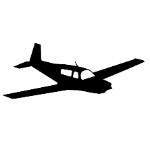









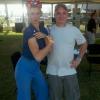
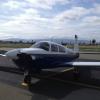



.thumb.png.7c67574d7b28f67b0b4a17760919b1ac.png)


